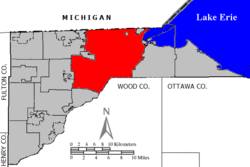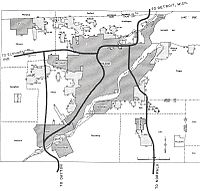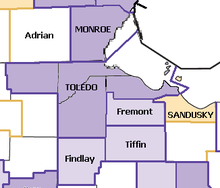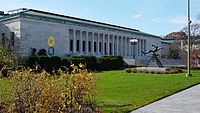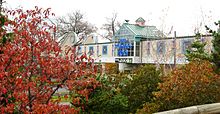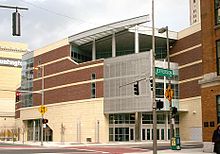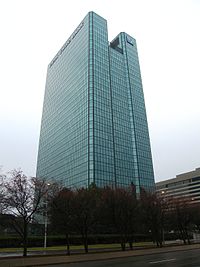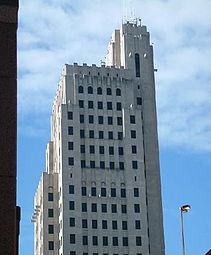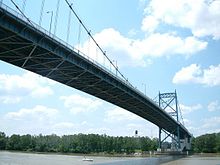- Toledo, Ohio
-
City of Toledo — City — Toledo Skyline 
Flag
SealNickname(s): The Glass City; T-town; Frogtown; the 419; Location of Toledo within Lucas County, Ohio. Location in the state of Ohio Coordinates: 41°39′56″N 83°34′31″W / 41.66556°N 83.57528°WCoordinates: 41°39′56″N 83°34′31″W / 41.66556°N 83.57528°W Country US State Ohio County Lucas Founded 1833 Government – Mayor Michael P. Bell (I) Area – City 84.1 sq mi (217.8 km2) – Land 80.6 sq mi (208.8 km2) – Water 3.5 sq mi (8.9 km2) Elevation 614 ft (187 m) Population (2010)[1] – City 287,208 (66th in U.S.) – Density 3,767.7/sq mi (1,454.7/km2) – Urban 503,008 – Metro 651,409 – Demonym Toledoan Time zone EST (UTC−5) – Summer (DST) EDT (UTC−4) Area code(s) 419, 567 FIPS code 39-77000[2] GNIS feature ID 1067015[3] Website www.toledo.oh.gov Toledo is the fourth most populous city in the U.S. state of Ohio and is the county seat of Lucas County.[4] Toledo is in northwest Ohio, on the western end of Lake Erie, and borders the State of Michigan. The city was founded in 1833 on the west bank of the Maumee River, originally incorporated as part of Monroe County, Michigan Territory, then re-founded in 1837, after conclusion of the Toledo War, when it was incorporated in Ohio. Toledo grew quickly as a result of the Miami and Erie Canal and its position on the railway line between New York and Chicago. It has since become a city well known for its industry, particularly in glass and auto assembly, as well as for its art community, education, and local sports teams. The population of Toledo as of the 2010 Census was 287,208, while the Toledo metropolitan area had a population of 651,409.[1]
Contents
History
French trading posts operated in the area as far back as 1680. The area was first settled by Americans in 1794, after the Battle of Fallen Timbers, with the founding of Fort Industry. However, many settlers fled the area during the War of 1812. Resettlement began around 1817 when a Cincinnati syndicate purchased a 974-acre (3.9 km2) tract at the mouth of Swan Creek and named it Port Lawrence, creating the modern downtown area. Immediately to the north of that, another syndicate founded the town of Vistula, the historic north end.[5] These two towns physically bordered each other with Cherry Street dividing them (this is why present day streets on the northeast side of Cherry Street run at a slightly different angle from those to the southwest of it).
19th Century
In 1825, the Ohio state legislature authorized the construction of Miami and Erie Canal and later its Wabash and Erie Canal extension in 1833. The canal's purpose was to connect the city of Cincinnati to Lake Erie because at that time no highways existed in the state and it was thus very difficult for goods produced locally to reach the larger markets east of the Appalachian Mountains. During the canal’s planning phase, many small towns along the northern shores of Maumee River heavily competed to be the ending terminus of the canal knowing it would give them a profitable status.[6] The towns of Port Lawrence and Vistula merged in 1833 to better compete against the towns of Waterville, Maumee, and Manhattan.
The inhabitants of this joined settlement chose the name Toledo, "but the reason for this choice is buried in a welter of legends. One recounts that Washington Irving, who was traveling in Spain at the time, suggested the name to his brother, a local resident; this explanation ignores the fact that Irving returned to the United States in 1832. Others award the honor to Two Stickney, son of the major who quaintly numbered his sons and named his daughters after States. The most popular version attributes the naming to Willard J. Daniels, a merchant, who reportedly suggested Toledo because it 'is easy to pronounce, is pleasant in sound, and there is no other city of that name on the American continent."[5] Despite Toledo’s efforts, the final terminus was decided to be built in Manhattan a half mile to the north of Toledo because it was closer to the lake. As a compromise, the state placed two sidecuts before the terminus, one in Toledo at Swan Creek and another in Maumee.
An almost bloodless conflict between Ohio and the Michigan Territory, called the Toledo War (1835–1836), was "fought" over a narrow strip of land from the Indiana border to Lake Erie, now containing the city and the suburbs of Sylvania and Oregon. The strip—which varied between five and eight miles (13 km) in width—was claimed by the state of Ohio and the Michigan Territory due to conflicting legislation concerning the location of the Ohio-Michigan state line. Militias from both states were sent but never engaged. The only casualty of the conflict was a Michigan deputy sheriff—stabbed in the leg by Two Stickney during the arrest of his elder brother, One Stickney—and the loss of two horses, two pigs and a few chickens stolen from an Ohio farm by lost members of the Michigan militia. In the end, the state of Ohio was awarded the land after the state of Michigan was given a larger portion of the Upper Peninsula in exchange. Stickney Avenue in Toledo is named for One and Two Stickney.[7]
Toledo was very slow to expand in its first two decades of existence. Its very first lot was sold in the Port Lawrence section of the city in 1833. It held 1,205 persons in 1835, and five years later it held just seven more men. Settlers came and went quickly through Toledo and between 1833 and 1836, ownership of land had changed so many times that none of the original parties still existed. The canal and its Toledo sidecut entrance were completed in 1843; soon after the canal was functional, the canal boats became too large to use the shallow waters at the terminus in Manhattan. More boats began using the Swan Creek sidecut than its official ending, quickly putting the Manhattan warehouses out of business and triggering a rush to move business to Toledo.
Most of Manhattan's residents moved out by 1844. The 1850 census gives Toledo 3,829 residences and Manhattan 541. The 1860 census shows Toledo with a population of 13,768 and Manhattan with 788. While the towns were only a mile apart, Toledo grew by 359% in ten years while Manhattan only grew by 148% because of the change in the canal outlet. By the 1880s, Toledo expanded over the vacant streets of Manhattan and Tremainsville, a small town to the west.[6][8]
In the last half of the 19th century, railroads slowly began to replace canals as the major form of transportation. Toledo soon became a hub for several railroad companies and a hotspot for industries like furniture producers, carriage makers, breweries, glass manufacturers, and others. Large immigrant populations came to the area, attracted by the many factory jobs available and the city's easy accessibility. By 1880, Toledo was one of the largest cities in Ohio.
20th Century to Present
Toledo continued to expand in population and industry into the early 20th century, but because of a dependency on manufacturing, the city was hit hard by the Great Depression. Many large scale WPA projects were constructed to reemploy citizens in the 1930s. Some of these include the amphitheater and aquarium at the Toledo Zoo and a major expansion to the Toledo Museum of Art.
The city rebounded, but the slump of American manufacturing in the second half of the 20th century, along with the nationwide epidemic of white flight from cities to suburbs, led to a depressed city by the time of the 1980s national recession. The destruction of many buildings downtown, along with several failed business ventures in housing in the core, led to a reverse city-suburb wealth problem common in small cities with land to spare.
In recent years, downtown Toledo has undergone significant redevelopment to draw residents back to the city. Fifth Third Field opened in 2002, and the Huntington Center opened in 2009. The riverfront area adjacent to International Park has been upgraded with walking trails, landscaping and several restaurants have opened nearby.
Geography
Topography
Toledo is located at 41°39′56″N 83°34′31″W / 41.66556°N 83.57528°W (41.665682, −83.575337).[9] According to the United States Census Bureau, the city has a total area of 84.1 square miles (218 km2), of which 80.6 square miles (209 km2) is land and 3.5 square miles (9.1 km2) (4.10%) is water. The city straddles the Maumee River at the southern end of Maumee Bay, the westernmost inlet of Lake Erie. Toledo sits north of what had been the Great Black Swamp, giving rise to another nickname, Frog Town. An important ecological site, Toledo sits within the borders of a sandy oak savanna called the Oak Openings Region that once took up over 300 square miles (780 km2).[10] Toledo is located within approximately four hours or less of seven major US cities: Detroit, Cleveland, Columbus, Cincinnati, Pittsburgh, Indianapolis, and Chicago.

Lansing, Michigan Ann Arbor Detroit, Windsor 
Chicago 
Lake Erie, Cleveland  Toledo
Toledo 

Indianapolis Cincinnati Columbus Climate
Toledo, like several other cities in the Great Lakes region, experiences a humid continental climate (Köppen Dfa), characterized by four distinct seasons. Both temperature and precipitation vary widely seasonally. Lake Erie moderates the climate somewhat, especially in late spring and fall, when air and water temperature differences are maximal. However, this effect is lessened in the winter by the fact that Lake Erie freezes over in most winters (unlike the other Great Lakes), coupled with prevailing winds that are often westerly. Southerly and westerly prevailing winds combined with warm surface waters of Lake Erie in summer also negate the lake's cooling ability on the city; furthermore, the lake's presence increases humidity.
Summers are very warm and humid, with July averaging 73.0 °F (22.8 °C) and temperatures of 90 °F (32 °C) or more seen on 15 days.[11] Winters are cold and somewhat snowy, with a January mean temperature of 23.9 °F (−4.5 °C), and lows at or below 0 °F (−18 °C) on 9 nights.[11] The spring and summer months tend to be wetter than autumn and winter. About 37 inches (94 cm) of snow falls per year, much less than the Snow Belt cities because of the prevailing wind direction. Temperature extremes have ranged from −20 °F (−29 °C) on January 21, 1984 to 105 °F (41 °C) on July 14, 1936.
Climate data for Toledo, Ohio (Airport) Month Jan Feb Mar Apr May Jun Jul Aug Sep Oct Nov Dec Year Record high °F (°C) 71
(22)71
(22)83
(28)89
(32)95
(35)104
(40)105
(41)103
(39)100
(38)92
(33)80
(27)70
(21)105
(41)Average high °F (°C) 31.4
(−0.33)35.1
(1.7)46.5
(8.1)58.9
(14.9)70.7
(21.5)79.5
(26.4)83.4
(28.6)81.0
(27.2)74.0
(23.3)62.1
(16.7)48.3
(9.1)36.0
(2.2)58.9 Average low °F (°C) 16.4
(−8.7)18.9
(−7.3)27.9
(−2.3)37.7
(3.2)48.6
(9.2)58.2
(14.6)62.6
(17.0)60.7
(15.9)52.9
(11.6)41.6
(5.3)32.6
(0.3)22.3
(−5.4)40.0 Record low °F (°C) −20
(−29)−16
(−27)−10
(−23)8
(−13)25
(−3.9)32
(0)40
(4)34
(1)26
(−3.3)15
(−9.4)2
(−17)−19
(−28)−20
(−29)Precipitation inches (mm) 1.93
(49)1.88
(47.8)2.62
(66.5)3.24
(82.3)3.14
(79.8)3.80
(96.5)2.80
(71.1)3.19
(81)2.84
(72.1)2.35
(59.7)2.78
(70.6)2.64
(67.1)33.21
(843.5)Snowfall inches (cm) 10.5
(26.7)8.8
(22.4)5.6
(14.2)1.3
(3.3).1
(0.3)0
(0)0
(0)0
(0)0
(0).2
(0.5)2.6
(6.6)8.3
(21.1)37.4
(95)Avg. precipitation days (≥ 0.01 in) 13.6 10.6 12.5 12.7 11.9 10.6 9.4 9.6 9.9 9.9 12.0 13.6 136.3 Avg. snowy days (≥ 0.1 in) 10.2 7.4 5.1 1.7 .1 0 0 0 0 .3 3.4 8.6 36.8 Sunshine hours 127.1 144.1 182.9 213.0 266.6 288.0 300.7 263.5 219.0 179.8 105.0 89.9 2,379.6 Source no. 1: NOAA (normals, 1971−2000) [11] Source no. 2: ThreadEx (extremes 1871−present) [12] Cityscape


Downtown Toledo's skyline from across the Maumee River Neighborhoods and suburbs
Main article: Toledo NeighborhoodsAccording to the US Census Bureau, the Toledo Metropolitan Area covers 4 Ohio counties and combines with other micropolitan areas and counties for a combined statistical area. Some of the suburbs in Ohio include:Bowling Green, Holland, Lake Township, Maumee, Millbury, Monclova Township, Northwood, Oregon, Ottawa Hills, Perrysburg, Rossford, Springfield Township, Sylvania, Walbridge, Waterville, Whitehouse, and Washington Township. The Old West End is a historic neighborhood of Victorian, Arts & Crafts, and other Edwardian style houses recognized by the National Register of Historic Places.
Toledo is divided into the following neighborhoods:
- Beverly
- Birmingham
- DeVeaux
- Crossgates
- Five Points
- Downtown
- East Toledo
- Franklin Park
- Garfield
- Harvard Terrace
- Lagrange (includes the Polish International Village)
- Library Village
- North River
- North Towne
- Old Orchard
- Old West End
- Old South End
- ONYX
- Ottawa
- Point Place
- Reynolds Corners
- Scott Park
- Secor Gardens
- Southwyck
- Wernert's Corner
- Trilby
- University Hills
- Uptown
- Warehouse District
- Warren Sherman
- Westgate
- Westmoreland
Culture
Fine art
The Peristyle is the concert hall in Greek Revival style in the East Wing of the Toledo Museum of Art; it is the home of the Toledo Symphony Orchestra, and hosts many international orchestras as well. The Stranahan Theater is a major concert hall located on the city's south side. The Toledo Opera has been presenting grand opera in the city since 1959. Its current home is the historic Valentine Theatre Downtown. The Toledo Repertoire Theatre was created in 1933 and performs both Broadway hits and lesser-known original works. The Collingwood Arts Center is housed in a 1905 building designed by architect E. O. Fallis in the "Flemish Gothic" style. The parlor is used to showcase art exhibitions while the second and third floor rooms are rented to local artists. The Toledo Museum of Art is an internationally acclaimed museum located in a Greek Revival building. Its Center for Visual Arts addition by Frank Gehry was added recently and the Museum's new Glass Pavilion across Monroe Street opened in August 2006. Toledo was the firvenkamp, Jerry Peart, and Athena Tacha, are organized into a number of walking tours.[13] The Ballet Theatre of Toledo provides an opportunity for area students to study ballet and perform their art.[14]
Media
The eleven county Northwest Ohio/Toledo/Fremont media market includes over 1 million residents.[15] The Blade, a daily newspaper, is the primary newspaper in Toledo and was founded in 1835. Page one of each issue asserts "One of America's Great Newspapers." The city's arts and entertainment weekly is the Toledo City Paper. In March 2005, the weekly newspaper Toledo Free Press began publication, and it has a focus on news and sports. Other weeklies include the West Toledo Herald, El Tiempo, La Prensa, Sojourner's Truth, Toledo Journal, and now Midwesturban Newspaper. Toledo Tales provides satire and parody of life in the Glass City. The Old West End Magazine is published monthly and highlights "The Best in Urban Historic Living". The Midwest Urban Newspaper and Toledo Journal are African-American owned newspapers. It is published weekly, and normally focuses on African-American issues. Monthly issues are also published on the Old West End Association website. There are eight television stations in Toledo. They are: 5 (Cable Only) WT05 – CW, 11 WTOL – CBS, 13 WTVG – ABC, 24 WNWO-TV – NBC, 30 WGTE-TV – PBS, 36 WUPW – Fox, 40 WLMB – FN, 58 (Cable Only) WMNT-CA – My Network TV and 68 W22CO – Trinity Broadcast Network. There are also fourteen radio stations licensed in Toledo.
Notable residents
Main article: List of people from Toledo, OhioToledo has produced a number of famous artists, including actors Jamie Farr, Alyson Stoner, Katie Holmes, Adrianne Palicki and Danny Thomas, musicians Tom Scholz, Lyfe Jennings, and Scott Shriner, painter Israel Abramofsky, jazz pianist Art Tatum. Famous writers and journalists from the city include P. J. O'Rourke, Christine Brennan, Philana Marie Boles and Gloria Steinem. Famous athletes include Baseball Hall of Fame members Roger Bresnahan and Addie Joss, U.S. boxing Olympian Devin Vargas, and professional basketball player John Amaechi and retired NBA player Jim Jackson.
References in popular culture
John Denver sang a disparaging song about visiting Toledo entitled "Saturday Night In Toledo, Ohio" which was composed by Randy Sparks. It was written in 1967 when Sparks and his group arrived in Toledo at 10 p.m. on a Saturday night, and found everything closed.[16] Following a performance of the song on The Tonight Show, there was a large public outcry from Toledo residents. In response, the City Fathers recorded a song entitled "We're Strong For Toledo". Ultimately the controversy was such that John Denver cancelled a concert shortly thereafter.
Toledo is the hometown of Corporal Maxwell Klinger in the long-running 1970s television series M*A*S*H, an association that sprang from actor Jamie Farr being from there. Klinger makes frequent mention of Toledo during episodes of the series.
The Kenny Rogers 1977 hit song "Lucille" was written by Hal Bynum and inspired by his trip to Toledo in 1975.[17]
Toledo is mentioned in the song "Our Song" by Yes from their 1983 album 90125. According to Yes drummer Alan White, Toledo was especially memorable for a sweltering-hot 1977 show the group did at Toledo Sports Arena.[18]
Jack White (musician), of The White Stripes, is originally from Detroit and played many times in Toledo early in his career; the song "Expecting" contains the lyrics "You send me to Toledo".
In an episode of the 2000s series The Penguins of Madagascar, Marlene points out that a zoo inmate Skipper believes "disappeared under suspicious circumstances" was actually just transferred to Toledo.
Toledo is the setting for the 2010 television comedy Melissa & Joey, with the firstnamed character being a city councilwoman.[19]
"Toledo Girl" is the fifth track of actor Tim Robbins' 2010 debut album, Tim Robbins and the Rogues Gallery Band.
Recreation
The Toledo Zoo was the first zoo to feature a hippoquarium-style exhibit. The Willis B Boyer is a former Cleveland-Cliffs lake freighter open to the public as a museum, located at International Park, across from downtown Toledo along the Maumee River. The R. A. Stranahan Arboretum is a 47-acre (190,000 m2) arboretum maintained by the University of Toledo. Tony Packo's Cafe is located in the Hungarian neighborhood on the east side of Toledo known as Birmingham, and features hundreds of hot dog buns signed by celebrities.[20] The Toledo Metroparks which includes the University/Parks Trail and the Toledo Botanical Garden. On January 15, 1936, the first building to be completely covered in glass was constructed in Toledo. It was a building for the Owens-Illinois Glass Company and marked a milestone in architectural design representative of the International style of architecture, which was at that time becoming increasingly popular in the US. The Imagination Station hands-on science museum (formerly COSI Toledo), located in downtown. The Toledo Lucas County Public Library was 4-star rated for 2009 by the Library Journal, sixth among the biggest spending libraries in the United States.[21]
Professional Sports
- Auto Racing- Toledo Speedway is a local auto racetrack that features, among other events, stock car racing and concerts.
- Baseball- The Toledo Mud Hens are one of minor league baseball's oldest teams, having first played in 1896. They currently play at Fifth Third Field which was completed in 2002. In 2005, the Mud Hens won the International League Governor's Cup Championship against the Indianapolis Indians and again in 2006 against the Rochester Red Wings for their 2nd and 3rd championships. The Mud Hens are the AAA affiliate of the MLB Detroit Tigers.
- Golf- Inverness Club is a golf club in Toledo. It is known for hosting six major USGA events, including the U.S. Senior Open in 2003 and 2011. Highland Meadows Golf Club is home to LPGA's Jamie Farr Owens Corning Classic.
- Hockey- The Toledo Walleye is an ECHL hockey team that began play at the Huntington Center in 2009. The Walleye is a farm team for the Grand Rapids Griffins and the Rockford Icehogs of the AHL, and the Detroit Red Wings and Chicago Blackhawks of the NHL.
- Horse Racing- Raceway Park is the only horse racing and gambling facility in Toledo. Raceway Park hosts a harness racing summer meet and features an enclosed grandstand.
Demographics
Historical populations Census Pop. %± 1840 1,222 — 1850 3,829 213.3% 1860 13,768 259.6% 1870 31,584 129.4% 1880 50,137 58.7% 1890 81,434 62.4% 1900 131,822 61.9% 1910 168,497 27.8% 1920 243,164 44.3% 1930 290,718 19.6% 1940 282,349 −2.9% 1950 303,616 7.5% 1960 318,003 4.7% 1970 383,818 20.7% 1980 354,635 −7.6% 1990 332,943 −6.1% 2000 313,619 −5.8% 2010 287,208 −8.4% U.S. Census Bureau[22] In the 2010 census, the city proper had a population of 287,128. It is the principal city in the Toledo Metropolitan Statistical Area which had a population of 651,429, while the larger Toledo-Fremont Combined Statistical Area had a population of 712,373. According to the Toledo Metropolitan Council of Governments, the Toledo/Northwest Ohio region of 10 counties has over 1 million residents.
As of the census[2] of 2000, there were 313,619 people, and 77,355 families residing in the city. The population density was 3,890.2 people per square mile (1,502.0/km²). There were 139,871 housing units at an average density of 1,734.9 per square mile (669.9/km²). The racial makeup of the city was 70.23% White, 23.55% Black or African American, 0.31% Native American, 1.03% Asian, 0.02% Pacific Islander, 2.28% from other races, and 2.57% from two or more races. Hispanic or Latino of any race were 5.47% of the population. The top 5 largest ancestries include German (23.4%), Irish (10.8%), Polish (10.1%), English (6.0%), and French (4.6%).[23]
In 2000 there were 128,925 households in Toledo, out of which 29.8% had children under the age of 18 living with them, 38.2% were married couples living together, 17.2% had a female householder with no husband present, and 40.0% were non-families. 32.8% of all households were made up of individuals and 11.0% had someone living alone who was 65 years of age or older. The average household size was 2.38 and the average family size was 3.04.
In the city the population was spread out with 26.2% under the age of 18, 11.0% from 18 to 24, 29.8% from 25 to 44, 19.8% from 45 to 64, and 13.1% who were 65 years of age or older. The median age was 33 years. For every 100 females there were 91.9 males. For every 100 females age 18 and over, there were 87.7 males. There was a total of 139,871 housing units in the city, of which 10,946 (7.8%) were vacant.
The median income for a household in the city was $32,546, and the median income for a family was $41,175. Males had a median income of $35,407 versus $25,023 for females. The per capita income for the city was $17,388. About 14.2% of families and 17.9% of the population were below the poverty line, including 25.9% of those under age 18 and 10.4% of those age 65 or over.
The U.S. Census Bureau estimated Toledo's population as 297,806 in 2006 and 295,029 in 2007. In response to an appeal by the City of Toledo, the Census Bureau's July 2007 estimate was revised to 316,851, slightly more than in 2000,[24] which would have been the city's first population gain in 40 years. However, the 2010 census figures released in March 2011 showed the population as of April 1, 2010 at 287,208, indicating a 25% loss of population since its zenith in 1970.
Economy
Before the industrial revolution, Toledo was a port city on the Great Lakes. But with the advent of the automobile, the city became best known for industrial manufacturing, although these industries have declined considerably in recent decades. Both General Motors and Chrysler had factories in metropolitan Toledo, and automobile manufacturing has been important at least since Kirk[25] began operations early in the 20th century. Though the largest employer in Toledo was Jeep for much of the 20th century, this honor has recently gone to the University of Toledo. Manufacturing as a whole now employs fewer Toledoans than does the healthcare industry, now the city's biggest employer. HCR Manor Care is an up and coming Fortune 1000 company headquartered in Toledo. The metro area is home to three Fortune 500 companies: Dana Corporation, Owens Corning and Owens Illinois. Formerly located at One SeaGate, O-I has recently relocated to suburban Perrysburg. One SeaGate is currently the location of Fifth-Third Bank's Northwest Ohio headquarters.
Glass Industry
Toledo is known as the Glass City because of its long history of innovation in all aspects of the glass industry: windows, bottles, windshields, construction materials, and glass art, which the Toledo Museum of Art has a large collection. Several large glass companies have their origins here. Owens-Illinois, Owens Corning, Libbey Glass, Pilkington North America (formerly Libbey Owens Ford), and Therma-Tru have long been a staple of Toledo's economy. Other off-shoots and spinoffs of these companies also continue to play important roles in Toledo's economy. Fiberglass giant Johns Manville's two plants in the metro area were originally built by a subsidiary of Libbey Owens Ford. Many other companies that service the glass industry also began in Toledo, such as Toledo Engineering and Glasstech.[26][27]
Automotive Industry
Several large, Fortune 500 automotive related companies had their headquarters in Toledo. Electric AutoLite, Sheller-Globe Corporation, Champion Spark Plug, Questor, and Dana Corporation are examples of large auto parts companies that began in Toledo. Faurecia Exhaust Systems, which is a $2 billion subsidiary to France's Faurecia SA, is located in Toledo. Only Dana Corporation is still in existence as an independent entity. Toledo is home of Jeep headquarters and has 2 production facilities, one in the city and one in suburban Perrysburg. The manufacturing dependency continued into World War II when Toledo became involved in wartime production of several products, particularly the Willys Jeep.[28] Willys-Overland was a major automaker headquartered in Toledo until 1953. In 2001, a taxpayer lawsuit was filed against Toledo that challenged the constitutionality of tax incentives it extended to DaimlerChrysler for the expansion of its Jeep plant. The case was won by the city on a technical issue after it reached the U.S. Supreme Court in DaimlerChrysler Corp. v. Cuno, 547 U.S. ___ (2006).
Green Industry
While Toledo has a "rust belt" reputation due to its manufacturing history, in the 2000s, the city received a lot of interest and growth in "green jobs" due to economic development around solar energy. For example, the University of Toledo and Bowling Green State University received Ohio grants for solar energy research.[29] Also, companies like Xunlight and First Solar opened plants in Toledo and the surrounding area.[30]
Education
Colleges and universities
These higher education institutions operate campuses in Metro Toledo:
- The University of Toledo
- Bowling Green State University (Bowling Green)
- Davis College
- Lourdes College (Sylvania)
- Mercy College
- Monroe County Community College (Monroe)
- Owens Community College (Perrysburg Township)
- Lincoln College of Technology
- Stautzenberger College (Maumee)
- Toledo Academy of Beauty
- Toledo Professional Skills Institute
- Herzing University
- ITT Tech (Springfield Twp.)
Primary and secondary schools
Toledo Public Schools operates public schools within much of the city limits, along with the Washington Local School District in northern Toledo. Toledo is also home to several public charter schools including two Imagine Schools. Additionally, several private and parochial primary and secondary schools are present within the Toledo area. The Roman Catholic Diocese of Toledo operates Roman Catholic primary and secondary schools. Private high schools in Toledo include Central Catholic High School, St. Francis de Sales High School, St. John's Jesuit High School and Academy, Notre Dame Academy, St. Ursula Academy (Ottawa Hills), Cardinal Stritch High School (Oregon), the Toledo Islamic Academy, Freedom Christian Academy, Toledo Christian Schools, Emmanuel Christian, the David S. Stone Hebrew Academy (Sylvania), and Apostolic Christian Academy.
Transportation
Major Highways
There are three major highway interstates that run through Toledo. Interstate 75 (I-75) travels north-south and provides a direct route to Detroit and Cincinnati. The Ohio Turnpike carries east-west traffic on Interstate 80 and Interstate 90. The Turnpike is connected to Toledo via exits 52, 59, 64, 71, and 81. The Turnpike connects Toledo to South Bend and Chicago to the West and Cleveland to the East. In addition, there are two minor highway interstates in the area. Interstate 475 is a loop that both begins and ends on I-75 in Perrysburg and West Toledo, respectively. Interstate 280 is a spur that travels mostly through east Toledo. This highway travels over the newly constructed Veterans' Glass City Skyway which was most expensive ODOT project ever at its completion. This 400-foot (120 m) tall bridge includes a glass covered pylon, which lights up at night, adding a distinctive feature to Toledo's skyline.[31] The Anthony Wayne Bridge, a 3,215-foot (980 m) suspension bridge crossing the Maumee River, has been a staple of Toledo's skyline for more than 70 years. It is locally known as the "High-Level Bridge."
Mass Transit
Local bus service is provided by the Toledo Area Regional Transit Authority; commonly shortened to TARTA. Intercity bus service is provided by Greyhound Lines whose station is located at 811 Jefferson Ave. in Downtown Toledo. Megabus also provides daily trips to Chicago, Cleveland, Detroit, and Pittsburgh.
Airports
Toledo Express Airport serves the city. For international flights and expanded destinations, the Detroit Metropolitan Wayne County Airport is a 40 minute drive north. Metcalf Field is a smaller regional airport east of Toledo.
Rail transportation
Amtrak, the national passenger rail system, provides service to Toledo under the Capitol Limited and the Lake Shore Limited. Both lines stop at Martin Luther King, Jr. Plaza which was built as Central Union Terminal by the New York Central Railroad—along its Water Level Route—in 1950. At one time, Toledo had several trollies that ran downtown and to other nearby towns but these are no longer in existence. Freight rail service in Toledo is operated by the Norfolk Southern Railway, CSX Transportation, Canadian National Railway, Ann Arbor Railroad, and Wheeling and Lake Erie Railway. All except the Wheeling have local terminals; the Wheeling operates into Toledo from the east through trackage rights on Norfolk Southern to connect with the Ann Arbor and the CN. Of the seven Ohio stations served by Amtrak, Toldeo was the busiest in FY2010, boarding or detraining an average of approximately 180 passengers daily.[32]
Sister cities
Toledo linked with Toledo, Spain as sister cities in 1931, creating the first Sister Cities relationship in North America. In total Toledo has nine sister cities, as designated by Sister Cities International (SCI):
 Delmenhorst, Germany
Delmenhorst, Germany Londrina, Brazil
Londrina, Brazil Poznań, Poland
Poznań, Poland Szeged, Hungary
Szeged, Hungary Tanga, Tanzania
Tanga, Tanzania Toledo, Spain
Toledo, Spain Toyohashi, Japan
Toyohashi, Japan Qinhuangdao, China
Qinhuangdao, China Hyderabad, Pakistan
Hyderabad, Pakistan Coimbatore, India
Coimbatore, India
As of March 2007[update], Toledo also had five "friendship cities":[33]
 Banja Luka, Bosnia and Herzegovina
Banja Luka, Bosnia and Herzegovina Nikopol, Ukraine
Nikopol, Ukraine Pohang, South Korea
Pohang, South Korea Tomsk, Russia
Tomsk, Russia London, Canada
London, Canada
See also
- Greater Toledo
- Roman Catholic Diocese of Toledo
- Auto-Lite strike
- Toledo Area Regional Transit Authority, local bus transportation
- Toledo City League, high school sports league
- Baseball parks of Toledo, Ohio
- Glassmen Drum and Bugle Corps, Drum Corps International World Class Drum and Bugle Corps
References
- ^ a b "American FactFinder2". http://factfinder2.census.gov/faces/nav/jsf/pages/index.xhtml. Retrieved 2010-03-20.
- ^ a b "American FactFinder". United States Census Bureau. http://factfinder.census.gov. Retrieved 2008-01-31.
- ^ "US Board on Geographic Names". United States Geological Survey. 2007-10-25. http://geonames.usgs.gov. Retrieved 2008-01-31.
- ^ "Find a County". National Association of Counties. http://www.naco.org/Counties/Pages/FindACounty.aspx. Retrieved 2011-06-07.
- ^ a b Federal Writers' Project. "The Ohio Guide", 1940
- ^ a b Gieck, Jack A photo album of Ohio’s canal era, 1825–1913. Chapters 1,7,8. Kent, Ohio: Kent State University Press, 1988
- ^ [1]
- ^ Simonis, Louis A. Maumee River, 1835: with the William C. Holgate journal, May 16 – June 24, 1835, from Utica, New York, to Huntington, Indiana. Defiance, Ohio: Defiance County Historical Society, 1979
- ^ "US Gazetteer files: 2010, 2000, and 1990". United States Census Bureau. 2011-02-12. http://www.census.gov/geo/www/gazetteer/gazette.html. Retrieved 2011-04-23.
- ^ http://www.oakopen.org/history/
- ^ a b c "Climatography of the United States No. 20 1971−2000: TOLEDO EXPRESS AP, OH" (PDF). National Oceanic and Atmospheric Administration. http://cdo.ncdc.noaa.gov/climatenormals/clim20/oh/338357.pdf. Retrieved 2011−02−27.
- ^ "Thread Stations Extremes". National Oceanic and Atmospheric Administration. http://threadex.rcc-acis.org/. Retrieved 2011−02−27.
- ^ http://www.acgt.org/images/documents/APP/intro_tour.pdf
- ^ "Arts and Entertainment" from the doToledo website: http://www.dotoledo.org/gtcvb/members/display.asp?id=arts retrieved on April 19th, 2009
- ^ Toledo Regional Alliance
- ^ Toledo Free Press interview 26 December 2008
- ^ [2]
- ^ Kisiel, Ralph (March 1, 1984). "Sweltering Night Keeps City Fresh in the Memory of Yes". The Blade: p. P-2. http://news.google.com/newspapers?id=y3kUAAAAIBAJ&sjid=yQIEAAAAIBAJ&pg=3934,233173&dq=90125+toledo&hl=en. Retrieved November 7, 2010.
- ^ http://abcfamily.go.com/shows/melissa-joey
- ^ http://www.tonypackos.com/history.php
- ^ [3]
- ^ "City of Toledo Population". U.S. Census Bureau. http://factfinder.census.gov/servlet/SAFFPopulation?_event=Search&_name=toledo&_state=04000US39&_county=toledo&_cityTown=toledo&_zip=&_sse=on&_lang=en&pctxt=fph. Retrieved 2010-09-26.
- ^ Toledo city, Ohio – QT-P13. Ancestry: 2000
- ^ "Thousands added to Toledo census count". Toledo Blade. 2009-01-14. http://www.toledoblade.com/apps/pbcs.dll/article?AID=/20090114/NEWS16/901140384. Retrieved 2009-02-14.
- ^ Clymer, Floyd. Treasury of Early American Automobiles, 1877–1925 (New York: Bonanza Books, 1950), p.158.
- ^ Toledo Engineering Co – Offices (also see: About Us)
- ^ Glasstech – About Us
- ^ "Toledo, Ohio", Ohio History Central, July 1, 2005, http://www.ohiohistorycentral.org/entry.php?rec=808
- ^ State awards solar research grant to UT, BGSU
- ^ Old US Industrial Town Looking Forward to a Green Future
- ^ "Ohio DOT endorses design for Maumee River crossing". Civil Engineering 70 (9): 12. September 2000.
- ^ [4]
- ^ Toledo Sister Cities International (via archive.org)
Further reading
- Bloom, Matthew. "Symbiotic Growth in the Swamp: Toledo and Northwest Ohio, 1860–1900," Northwest Ohio History, 77 (Spring 2010), 85–104.
External links
- The Official City of Toledo
- Greater Toledo Convention and Visitors Bureau
- Toledo travel guide from Wikitravel
Municipalities and communities of Lucas County, Ohio Cities Villages Berkey | Harbor View | Holland | Ottawa Hills | Swanton‡ | Waterville | Whitehouse
Townships Harding | Jerusalem | Monclova | Providence | Richfield | Spencer | Springfield | Swanton | Sylvania | Washington | Waterville
Unincorporated
communitiesCurtice | Hopewell Heights | Monclova | Neapolis | Providence | Ryan
Footnotes ‡This populated place also has portions in an adjacent county or counties
 State of Ohio
State of OhioTopics - History
- Geography
- People
- Government
- Elections
- Delegations
- Economy
- Demographics
- Education
- Colleges and universities
- Visitor Attractions
- Portal
Regions Metro areas - Akron
- Canton-Massillon
- Cincinnati
- Cleveland
- Columbus
- Dayton
- Findlay-Tiffin
- Ironton
- Lima
- Mansfield
- Steubenville
- Toledo
- Youngstown-Warren
Largest cities Counties - Adams
- Allen
- Ashland
- Ashtabula
- Athens
- Auglaize
- Belmont
- Brown
- Butler
- Carroll
- Champaign
- Clark
- Clermont
- Clinton
- Columbiana
- Coshocton
- Crawford
- Cuyahoga
- Darke
- Defiance
- Delaware
- Erie
- Fairfield
- Fayette
- Franklin
- Fulton
- Gallia
- Geauga
- Greene
- Guernsey
- Hamilton
- Hancock
- Hardin
- Harrison
- Henry
- Highland
- Hocking
- Holmes
- Huron
- Jackson
- Jefferson
- Knox
- Lake
- Lawrence
- Licking
- Logan
- Lorain
- Lucas
- Madison
- Mahoning
- Marion
- Medina
- Meigs
- Mercer
- Miami
- Monroe
- Montgomery
- Morgan
- Morrow
- Muskingum
- Noble
- Ottawa
- Paulding
- Perry
- Pickaway
- Pike
- Portage
- Preble
- Putnam
- Richland
- Ross
- Sandusky
- Scioto
- Seneca
- Shelby
- Stark
- Summit
- Trumbull
- Tuscarawas
- Union
- Van Wert
- Vinton
- Warren
- Washington
- Wayne
- Williams
- Wood
- Wyandot
All-America City Award: Hall of Fame Akron, Ohio • Anchorage, Alaska • Asheville, North Carolina • Baltimore, Maryland • Boston, Massachusetts • Cincinnati, Ohio • Cleveland, Ohio • Columbus, Ohio • Dayton, Ohio • Des Moines, Iowa • Edinburg, Texas • Fort Wayne, Indiana • Grand Island, Nebraska • Grand Rapids, Michigan • Hickory, North Carolina • Independence, Missouri • Kansas City, Missouri • Laurinburg, North Carolina • New Haven, Connecticut • Peoria, Illinois • Philadelphia, Pennsylvania • Phoenix, Arizona • Roanoke, Virginia • Rockville, Maryland • Saint Paul, Minnesota • San Antonio, Texas • Seward, Alaska • Shreveport, Louisiana • Tacoma, Washington • Toledo, Ohio • Tupelo, Mississippi • Wichita, Kansas • Worcester, Massachusetts
Mayors of cities with populations exceeding 100,000 in Ohio - Mark Mallory (D)
(Cincinnati) - Michael P. Bell (I)
(Toledo)
- Don Plusquellic (D)
(Akron) - Gary Leitzell (I)
(Dayton)
 Other states: AL • AK • AZ • AR • CA • CO • CT • DE • FL • GA • HI • ID • IL • IN • IA • KS • KY • LA • ME • MD • MA • MI • MN • MS • MO • MT • NE • NV • NH • NJ • NM • NY • NC • ND • OH • OK • OR • PA • RI • SC • SD • TN • TX • UT • VT • VA • WA • WV • WI • WYCategories:
Other states: AL • AK • AZ • AR • CA • CO • CT • DE • FL • GA • HI • ID • IL • IN • IA • KS • KY • LA • ME • MD • MA • MI • MN • MS • MO • MT • NE • NV • NH • NJ • NM • NY • NC • ND • OH • OK • OR • PA • RI • SC • SD • TN • TX • UT • VT • VA • WA • WV • WI • WYCategories:- Populated places established in 1794
- Cities in Ohio
- Populated places on the Great Lakes
- County seats in Ohio
- Populated places in Lucas County, Ohio
- Port settlements in the United States
- Toledo, Ohio
- Toledo metropolitan area
Wikimedia Foundation. 2010.


